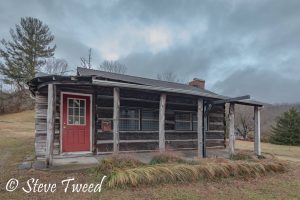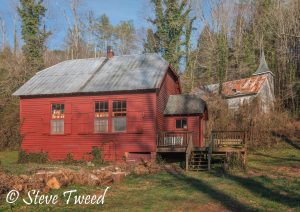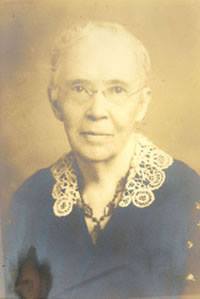Hi, folks!
If you are ever roaming through the Little Laurel Community of Madison County, North Carolina on NC Highway 208 you will notice a silver and black historical marker on the side of the road about 2 miles from the Tennessee state line.
Like most historical markers, it offers a brief notation and reason for it’s presence. On this particular marker, the name of one Frances L. Goodrich (1856-1944), Presbyterian Teacher & Missionary, is emblazoned across the top with said brief notation.
 However, this marker offers no true insight into the recipient’s struggle, hard work and dedication she demonstrated throughout her life. Simply stated, Miss Frances Louisa Goodrich was no ordinary woman.
However, this marker offers no true insight into the recipient’s struggle, hard work and dedication she demonstrated throughout her life. Simply stated, Miss Frances Louisa Goodrich was no ordinary woman.
To be honest, I had breezed right by that sign hundreds of times without giving it much thought until I married my wife, Lou Anne, in April of 2002. Only then did I begin to understand the contributions that Frances Goodrich made to not only Madison County but also to Appalachian Culture, the Arts and Humanity itself.
You see, Lou Anne and I live in what was once part of a Presbyterian Mission in the Shelton Laurel Community. Presbyterian Missions once dotted the Madison County landscape, three that I know of in the community of the Laurels. My own maternal great-great grandfather, E.B. Roland, gave property at Poplar Gap on the other side of the county to the Presbyterian Church for a mission. Our property in particular holds the remnants of the old Whiterock Hospital which came into existence at the insistence and persistence of Miss Goodrich. In our possession are documentarian tidbits on the contributions of The Presbyterian Church to Madison County, Miss Goodrich in particular.
However, for this week I would like to concentrate on her contributions to mountain families’ sustenance and the Arts community itself and then talk about the old hospital next week, if that’s okay by y’all.
 Miss Goodrich was born in Binghamton, New York in 1856, the great granddaughter of Noah Webster.
Miss Goodrich was born in Binghamton, New York in 1856, the great granddaughter of Noah Webster.
In the expectations and footsteps of her great grandfather, Goodrich was educated at Yale University’s School of Fine Arts from 1879 through 1882. She received a ‘Certificate of Attendance’ instead of a Degree, as Yale did not award women degrees in spite of their hard work and studious endeavors at that time.
Afterwards, she lived in Europe for several years, mainly France.
How in the world she wound up in the Riceville Community of Buncombe County in 1890 is anybody’s guess I suppose, but she did, building a library in her late fathers’ memory.
By 1896 or 1897, Goodrich arrived in the Allanstand Community of Madison County, better known nowadays as Little Laurel.
 On the property purchased by the Ladies Home Mission of The Presbyterian Church, a home, school and church were built for Goodrich. The father of my late teacher and employer, Louie Zimmerman, was a Minister there. All three buildings still stand and are in good shape with the little red schoolhouse being rented as a home. Miss Goodrich house still holds its old light peach colored paint.
On the property purchased by the Ladies Home Mission of The Presbyterian Church, a home, school and church were built for Goodrich. The father of my late teacher and employer, Louie Zimmerman, was a Minister there. All three buildings still stand and are in good shape with the little red schoolhouse being rented as a home. Miss Goodrich house still holds its old light peach colored paint.
Upon Miss Goodrich’s arrival, she was appalled to find the hardship endured by mountain families.
Most people had no formal education, women in particular. Per tradition, women were expected to marry and take care of their families. Folks who could read held an almost Godlike status within the community.
However, Appalachian women in the area were very resilient and resourceful. They knew how to make things including quilts, baskets, yarn, rugs, thread and coverlets among other things.
As a gift, Miss Goodrich was presented a pre-Civil War coverlet which in her words was dyed a ‘beautiful chestnut oak’.
Although mountain women viewed these talents as necessary abilities, Miss Goodrich recognized the artistic value in them all.
As a result, she started Allanstand Cottage Industries, gathering these crafts from women within the community. She even had a small cabin built on the property as a “store” of sorts.
 Although it was later moved to another site, the cabin still stands. Given that it was built in the traditional Appalachian style, I can’t help but wonder if Miss Goodrich paid for its construction of her own accord and on her own dime.
Although it was later moved to another site, the cabin still stands. Given that it was built in the traditional Appalachian style, I can’t help but wonder if Miss Goodrich paid for its construction of her own accord and on her own dime.
Allanstand Cottage Industries became very successful, with the wares being shipped up north, sold and the monies returned to Madison County, dispersed among the producing women in order to help them provide for their individual families.
The demand for products, combined with her driven nature and intense work ethic, caused Miss Goodrich to place great expectations upon her impromptu production staff. As a result, she wasn’t always held in the highest esteem as a supervisor.
Paula Shelton McAlister still has the spinning wheel her grandmother used to produce some of the wares mentioned.
According to Shelton, her grandmother referred to Miss Goodrich as ‘a real slave driver’.
Nevertheless, the business was very successful with Goodrich even opening a shop in the Biltmore section of Asheville.
However, as the old adage goes, all good things must come to an end.
The Stock Market Crash of October, 1929 brought the onset of The Great Depressions. Nobody was exempt. Although folks in deep Appalachia probably couldn’t tell much difference, American citizens in more urban areas were hit particularly hard. Funding for missions, the old hospital and other projects disappeared.
By this time, Frances Goodrich had long been retired from her teaching profession.
Sometime the next year, in 1930, Goodrich gave Allanstand Cottage Industries to a fledgling art organization, although she would be a founding charter member.
This organization came to be known as The Southern Highlands Craft Guild. Their shop is still in Historic Biltmore Village, although I am unsure as to whether it is the same building in which Allanstand’s shop was.
For those traveling across the famed Blue Ridge Parkway near Asheville, Allanstand Cottage Industries also holds a presence at what is known as The Folk Art Center.
Who would have thought that an effort to help mountain women improve their families’ livelihoods would turn into such a significantly important and iconic cultural landmark?
Afterwards, Goodrich wrote the book “Mountain Homespun” which was released in 1931 and then reprinted in 1989. Copies are easily available.
Frances Louisa Goodrich died in Asheville, North Carolina on February 20, 1944 at the age of eighty-eight a champion and heroin of Appalachian People & Culture, specifically women.
How ironic and appropriate that Goodrich, a woman who had been refused a degree by Yale University, wound up being that champion for Appalachian Women in Madison County. Much like Goodrich, these women had been denied educational opportunities but for far different reasons.
Miss Goodrich body was interred in the Goodrich Family plot at Lakeview Cemetery in Cleveland, Ohio.
I find it beyond fitting that she lies in the same cemetery that also holds the likes of John D. Rockefeller and Eliot Ness, her contributions to mankind every bit as important in my opinion.
Y’all have a great week!
*Authors Note*
Frances L. Goodrich Photo Credit – Western Carolina University , www.wcu.edu
